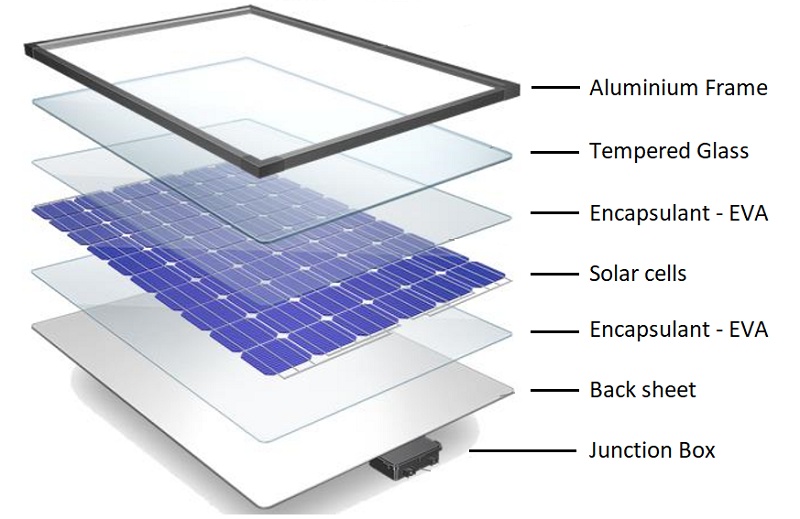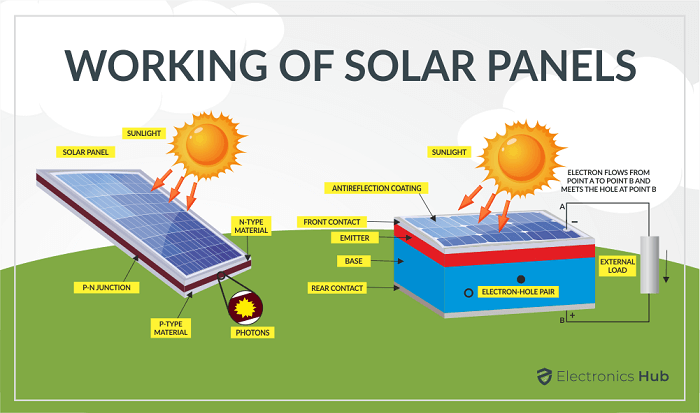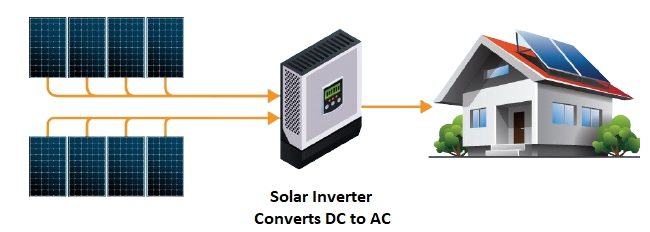Solar panel installations have become quite common in the last few years, thanks to the reduced prices.
But one question still persists among the consumers that is – how do solar panels work in providing continuous electricity.
Understanding the working mechanism of a solar panel system helps in getting the maximum of the investment – by installing it in the right place, considering the maintenance needs and others.
Hence, we are going to explore every detail of the working principle of solar panels in this article. First, let’s start with knowing the different components present in a solar panel.
Outline
ToggleComponents of a Solar Panel
- A Solar Cell is made up of two layers of silicon, each specially treated to allow electricity to flow through it.
- A Solar Panel is composed of many solar cells.
- A solar array is a collection or multiple of solar panels that produce electricity together.
- Photovoltaic (or solar photovoltaic) helps in generating of electricity from sunlight’s energy using PV cells.
Now that you understood the components lets dive into the working mechanism.
What are Solar Panels?
A solar panel can be described as a grid of silicon and glass wires that convert sunlight into electricity.
The most fundamental component of solar panels is the photovoltaic (PV), cells. A panel is composed of a collection of interconnected PV cells. A solar array is a collection of panels also known as modules.
A PV cell measures approximately 6 inches in length by 6 inches in width. It is squarish and appears like a small reflective window. The size of the module determines the number of photovoltaic cell required to make an array. A 12-volt module can have 36 cells connected to a grid. A 24-volt module can have almost 72 cells.
Every cell has layers of semiconductive materials that are oppositely charged. Silicon is the second most abundant element on Earth after oxygen.
Semiconducting material in solar electric technology is crystalline silicon. This material is used in residential solar panels. It can be either monocrystalline or polycrystalline.
Monocrystalline panels are made of single-crystal silicon. They have a dark uniform appearance and rounded edges. Polycrystalline panels, made from multi-crystalline silicon, have a speckled look and square edges.
The purity of the silicon cells in a solar panel will determine its efficiency. Monocrystalline cells are purer and can produce more solar power from less space than those with polycrystalline cells. Although there are many types of solar modules available, they are not suitable for home installation.
What is Solar Energy?
Before we move on to solar-powered panels, let’s try to understand solar energy in brief. To put it simply, solar energy is the energy received from the Sun, which has existed even before the earth was a habitable planet. Ever since, the Sun has been showering the earth with hundreds of thousands of terawatts of energy daily. Such high energy capacity is equivalent to nearly 10000 times of the energy utilized on the globe on a daily basis.
This should give you a good idea about the potential of solar energy and how it is going to be the power source of the future. But still, the majority of industries and households are dependent upon conventional energy sources that is generation using fossil fuels. The main reason for this is converting solar energy to electrical energy requires solar panels, which used to be quite expensive when they were first introduced.
But now, a lot of countries are turning to solar energy and promoting the production and distribution of solar panels. Thus, the overall cost of utilizing solar energy has decreased a lot in recent years so that anyone can get a solar panel system set up at their homes for “free energy”.
According to the International Energy Agency, solar energy is the world’s fastest growing source of energy, and rightfully so as it is the cleanest source of energy that does not damage the environment as there are no byproducts of solar energy. Thus, you should invest in a solar panel system right now. But before you decide to buy a solar panel, let’s try to understand how solar panels work.
How Do Solar Panels Work?
Sunlight is a natural power house that releases electromagnetic radiation called photons. The panels are designed to generate electricity using the photovoltaic effect which is a combination of chemical and physical phenomenon that transforms solar energy to usable power.
To simply put, when the module comes in contact with sunlight, the solar cells will absorb photons which is converted into AC that powers the home. Below, is the step-by-step explanation of how solar panels work.
Absorbing the Photons –
Photons are like tiny particles in the sun light which knock the electrons in the atoms for creating holes in solar cells. The negatively charged electrons and the positively charged hole now have enough space to move around.
When the solar cell comes in contact with photon, it will trigger a negative and positive charges that result in electric and voltage current. In the silicon cells, the atoms will separate quickly and the electrons will join the current flow.
Solar Panels Generating Current
Solar cells will transform the accumulated photons into DC (direct current). Every solar cell contains crystalline silicone which is sandwiched between positive and negative conductive layer. The positive layer contains extra space for holes while the negative layer contains extra electrons. The area where two layers meet, the electrons are free to wander creating negative charge on side and position charge on another.
Every cell puts about half a volt so they are mostly strung together to form a module in order to power up the house. For example, it needs 12 photovoltaic cells for charging a cell phone and for powering an entire house, you will need several modules. Solar panels produce currents efficiently using a wide range of convertible wavelengths.
Inverter Changes DC to AC
In order to convert the DC current accumulated by the solar cells to AC, an inverter is attached to the solar panels. The inverter is responsible for transformation as the power compatible with our house outlets is AC. The power accumulated from a solar panel is direct current (DC). When the inverter converts the DC to AC energy, a small amount of power is lost during the transformation.
Solar power systems usually come with microinverter connected to each panel or a single inverter for the whole system. Whatever may be the arrangement, the main responsibility of an inverter to transform DC to AC.
AC Current is Available –
Through the inverter, the AC electricity will flow into an external circuit and next through the home. This energy can be used for powering up appliances, lights, televisions and the rest of the electrical system in your home. In some cases, solar panels generate more power than your home needs. In those cases, the rest of the electricity can be stored in a battery bank or sold to a grid.
Storing or Selling the Extra Power –
The extra power can be storied in a solar battery. Or else, you can choose to sell the extra power to local utility company using a net metered program. If not, you can invest in a solar storage battery This provides 27/7 access to solar power, even when during monsoons and cloudy days where sunlight is less. If the initial installation investment isn’t a problem, then storage battery is mostly the better option.
If you are selling, the local utility company will pay you for generating electricity in form of credits. Power production credits usually help to reduce the electricity bills. However, you cannot convert them into cash or get direct cash deposits.
Some Frequently Asked Questions
Solar panels respond to visible light. If it is visible enough for the panels to generate electricity, then they will produce light. The more sunlight, the more power that solar panels can generate.
Solar panels generate more electricity during summer than in winter, so it could appear that they require warmer temperatures to function. This is not true. It is just that, sunlight and warmer temperature go hand-in-hand. In fact, if the temperatures are too hot or too cold, it can impact the efficiency of solar panels.
When photons from sunlight knock out electronics in silicon PV cells, solar panels generate direct-current electricity (DC). Each solar cell is made up of a positive and a negative layer, just like regular household batteries. This creates a DC electrical field which means that the flow of electricity in the circuit is in one direction. An inverter is required to convert DC electricity into usable power, as most homes are wired for AC electricity.
Most people are not able to build solar panels. The manufacturing process and technology are too complex.
While solar modules need sunlight to produce electricity, your system can still supply power even when it is dark. A storage battery stores excess solar energy for later use. This allows you to still use solar energy even when your panels don’t produce electricity. You can still get power from the grid if your rooftop solar panels don’t produce enough power to supply your electricity needs.
Yes, you will still get an electric bill if your solar panels are connected to the grid. But it is possible that you won’t owe any money. If your panels don’t produce enough energy or you have increased your energy use since installation, you may still owe money to your utility. You will need to have solar battery backup if you plan to rely entirely on solar energy.
Final Takeaway
Getting solar panel system installed is very important as it is most sustainable power generating alternative. As sun light is evergreen natural resource, it reduces the carbon print as well.
Before getting the solar panels installed, it is important to know how the system works. It helps in deciding whether it works for your requirements or not. In addition to that, you can install them in a better place.
We have mentioned a clear description of how the solar panel works in this article. Hope it helped you understand the process.
If you still have any queries, write to us in the comment section below. We will reply to them at the earliest.





One Response
Thank you sharing nice information.
appreciate you.